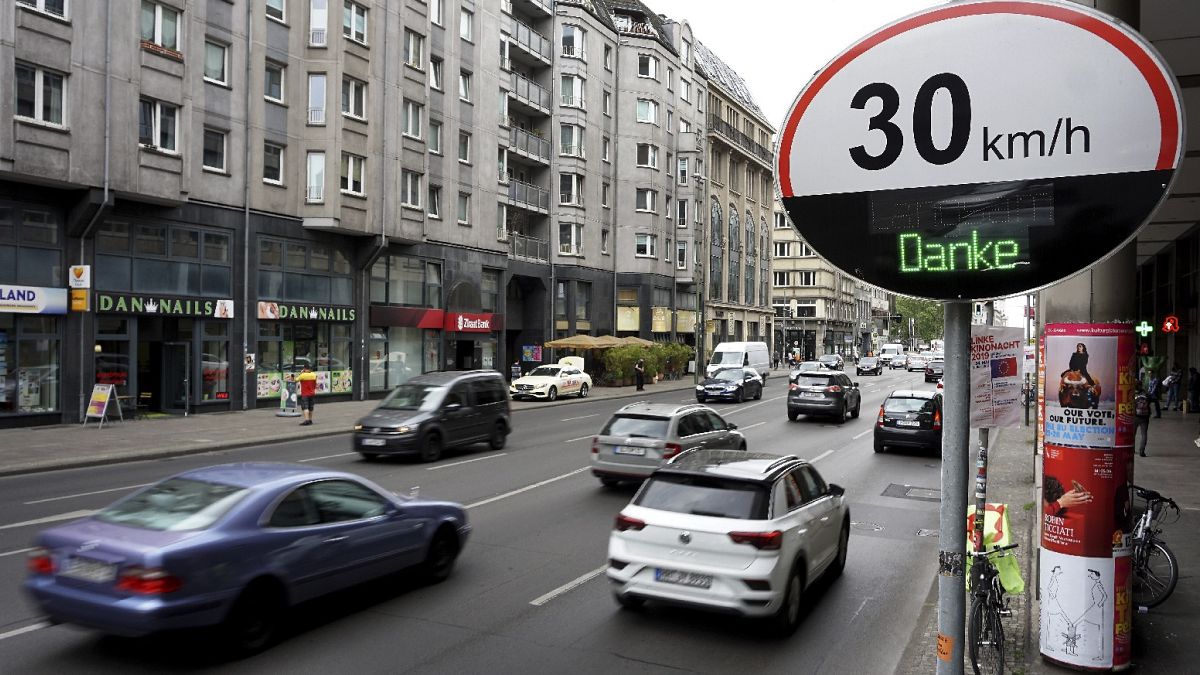Bologna became the first major Italian city this month to adopt the "City 30" model, a mobility strategy based on imposing a 30 km/h speed limit on the main areas of an urban road network in a bid to reduce accidents as well as air and noise pollution.
For Valentina Orioli, the city's councillor for mobility and public spaces, this will "create a safer, cleaner, and more liveable city which can face the challenges of sustainability."
The potential benefits are appealing: less traffic and car accidents, reduced air and noise pollution, and more space for bikes and pedestrians. Orioli confidently told Euronews that the system will create "a seamless mobility, which will tailor the city to the needs of its residents."
Bologna may be the first Italian city to roll out this policy, but it is in good company across Europe with dozens of cities and towns having already curtailed their speed limits to increase safety and transform the way people interact with the surrounding environment.
But does the City 30 model actually deliver on its promises? Data suggests it does.
An urban philosophy
"The first concept of ‘Zone 30’ started in the Netherlands in the early 1970s, when a group of parents blocked a whole neighbourhood to demand that no more children die in car crashes," Matteo Dondé, an Italian architect and urban planner, told Euronews.
It was the beginning of the Stop de Kindermoord (“Stop the child murder”) campaign, which eventually led Amsterdam to become the cycling capital we all know today.
From there, the Zone 30 idea evolved into an innovative urban development model which aims to reshape the use of public spaces, prioritising pedestrians at the expense of cars and heavy vehicles. The main tool to achieve this is by lowering the speed limits in interested areas, setting a 30 km/h limit as the norm and granting a 50 km/h exception only on some of the widest roads.
According to Dondé, the first and "most important" result of the City 30 model is a decrease in car crashes and related deaths, since studies show that collisions at a 30 km/h speed rarely result in fatalities.
In turn, this can lead to further benefits, such as reducing traffic and noise levels, promoting a healthier lifestyle for residents, and mitigating the effects of so-called “urban heat islands” — small areas in crowded, densely built-up environments which tend to get warmer due to human activities.
From Graz to Brussels
The first European city to adopt the City 30 model was Graz, in Austria, which imposed a city-wide speed limit of 30 km/h in 1992. Today, the limit is still enforced on about 80% of the city’s road network.
"In the beginning we met some resistance against this measure, but nowadays nobody would eliminate it,” Christian Kozina-Voit, Graz Councillor for transports and the environment, told Euronews.
The administration, in fact, has no plan to abandon it: “We have better air quality, fewer emissions, less noise, less dangerous traffic accidents. There are many advantages,” said Kozina-Voit.
Brussels adopted the City 30 model in 2021. “We immediately noticed a visible and constant reduction in the average speed on all our roads, and this has been maintained over the past two years,” said Camille Thiry, spokesperson for Bruxelles Mobility.
More importantly, the number of pedestrians killed or seriously injured in traffic has been steadily declining, so much so that "the figures for the third quarter of 2022 are the lowest ever recorded in Brussels since 2004."
“The City 30 model works," Thiry said, "and we have no regrets about having implemented this action as part of our overall mobility plan.” Moving forward, though, the city plans to focus more on the prosecution of offenders.
Paris, Grenoble, and Edinburgh also adopted the City 30 model, while other cities are considering the possibility, like Luxembourg and Milan.
Spain went a step further and in 2021 introduced a nationwide 30 km/h speed limit for one-lane roads, and 20 km/h for streets where the pavement is not physically separated from the carriageway.
By then, however, some cities had already implemented the City 30 system and adapted it to their specific morphology: Barcelona, for instance, spent years working on an innovative system of “superblocks,” grids of small neighbourhoods designed for cyclists and pedestrians, where car traffic is extremely limited.
Academic challenges
Data from cities that adopted the City 30 model all point to improvements in terms of road safety and life quality. However, isolating the actual impact of the policy is a difficult task, said Anna Bornioli, senior researcher at the Erasmus University of Rotterdam.
"Generally, the 30 km/h speed limit is part of a wider plan to promote sustainable mobility, which can involve other measures such as bike sharing programmes or structural changes. These measures are often enforced simultaneously, so it’s hard to understand how each one of them contributes to the overall results."
Matthew Watkins, principal lecturer at Nottingham Trent University, agrees that the City 30 model "is a great idea for road safety," but claims that more research is needed on its implications, for instance on air pollution.
"Some evidence suggests that air pollution can be higher with the City 30 system," he told Euronews. However, even though cars could pollute more if forced to travel at lower speeds, the lighter traffic could compensate for this. "There are many factors at play," Watkins said.
One thing is certain: “Traditionally, cities were made for cars, but over the last decades this paradigm has been overturned to put people first,” said Bornioli.
In this context, the City 30 model calls for a new way of living in the urban space and a reassessment of cars and pedestrians’ needs. As more and more European cities adopt it, and more data is gathered, it will become clearer whether the model is truly sustainable.
At the moment, it seems to be working.
